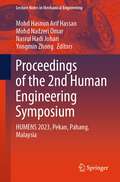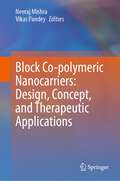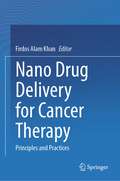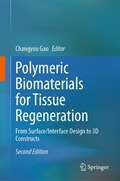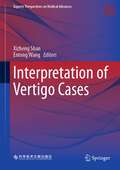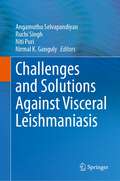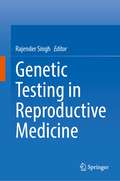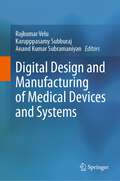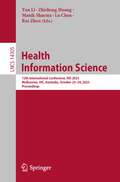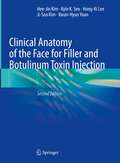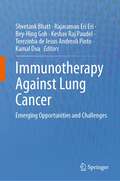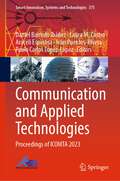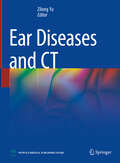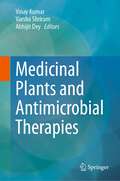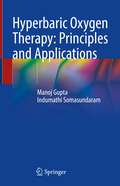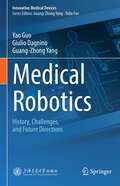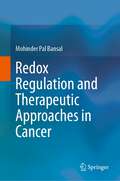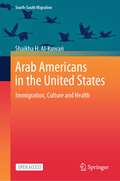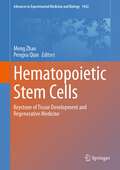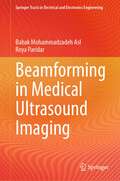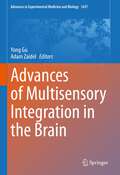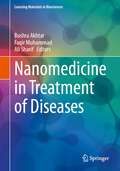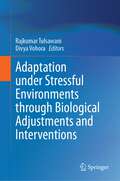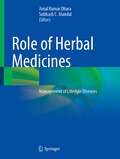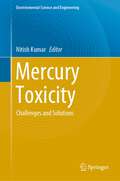- Table View
- List View
Proceedings of the 2nd Human Engineering Symposium: HUMENS 2023, Pekan, Pahang, Malaysia (Lecture Notes in Mechanical Engineering)
by Mohd Hasnun Arif Hassan Mohd Nadzeri Omar Nasrul Hadi Johari Yongmin ZhongThis book acts as a compilation of papers presented in the 2nd Human Engineering Symposium (HUMENS 2023), held at Pekan, Pahang, Malaysia. The symposium covers the following research topics: ergonomics, biomechanics, sports technology, medical device and instrumentation, artificial intelligence / machine learning, industrial design, rehabilitation, additive manufacturing, modelling and bio-simulation, and signal processing. The articles published will be of interest to researchers and practitioners from the medical device manufacturers, healthcare, rehabilitation and sports technology.
Block Co-polymeric Nanocarriers: Design, Concept, and Therapeutic Applications
by Neeraj Mishra Vikas PandeyThis book focuses on current advancements in the field of block copolymers and covers design, concept, and various therapeutic applications in the drug delivery. It also reviews the use of block copolymers in drug delivery applications from the development of sustained release products to smart polymeric delivery systems such as stimuli-responsive polymeric systems, for example, thermosensitive, redox-sensitive, photo-sensitive, and enzyme-sensitive. The book further discusses the nano assemblies from amphiphilic block copolymers as nanomedicine platforms for diagnosis and therapy due to their relatively small size, high drug loading capacity, controlled drug release, in vivo stability, and prolonged blood circulation. The chapters also review the various patents and ongoing clinical trials on the applications, covering several important new concepts and findings in the field of block copolymers. The book is aimed at researchers, academicians, and industrial scientists involved in the development of drug-delivery systems based on polymers.
Nano Drug Delivery for Cancer Therapy: Principles and Practices
by Firdos Alam KhanThis book discusses the various modes and methods of nano-based drug delivery in different types of cancers such as colon, breast, cervical, ovarian, and lung cancer. It reviews the significance of nano drug delivery in cancer therapy, the application of nanoparticles in overcoming drug resistance, targeted therapy, and immunotherapy. The book also covers topics related to the synthesis of different types, shapes, and sizes of nanocarriers using synthetic and biological approaches. Further, a chapter explores the synthesis of nanocarriers loaded with anti-cancer drugs by using functionalization or conjugations and encapsulation methods. The book also examines the nanocarriers as delivery vehicles for chemotherapeutic agents against cancers using in vitro and animal models of cancers, preclinical trials for efficacy, and safety profiling of nanocarriers. Finally, future trends and innovation in nano drug delivery for cancer therapy, application of siRNA (nanoparticle-based RNA) therapy, ultrasound-linked nano-cancer therapeutics, and application of exosome-based cancer therapy topics are discussed. Towards the end, the book examines the limitations of nanocarriers, including the cell and tissue toxicity, genotoxicity, and scale-up of nanomaterials, health and environmental hazards associated with nanoformulation synthesis, respiratory diseases, government regulations, and ethical issues.
Polymeric Biomaterials for Tissue Regeneration: From Surface/Interface Design to 3D Constructs
by Changyou GaoThis book reviews state of the art of polymeric biomaterials for regenerative medicine and highlights advances in both fundamental science and clinical practice. It summarizes the latest techniques in polymeric scaffold fabrication, delivery carriers, physiochemical property modulation, as well as their influence on the adhesion and performance of biomolecules, cells, and tissues. It also describes methods for creating biofunctional surfaces/interfaces and subsequently modulating the host response to implantable materials. Lastly, it discusses the applications of biomaterials and constructs in soft-tissue regenerative medicine. It is a valuable resource for materials scientists and engineers wishing to identify research priorities to fulfill clinical needs and provides physicians with insights into emerging novel biomaterials. This integrated approach also offers engineering students a sense of the relevance of materials science in the development of novel therapeutic strategies. In the second edition, most of the chapters are updated according to the latest progress of this research field. A new chapter on nerve regeneration is also included.
Interpretation of Vertigo Cases (Experts' Perspectives on Medical Advances)
by Xizheng Shan Entong WangThis book includes 35 vertigo cases, which covers typical cases, difficult cases and rare cases from the department of otorhinolaryngology, neurology, emergency department, geriatrics, ophthalmology, and other disciplines. In each case, it has uniform structure, which includes summary of medical records, case study and case view.This book starts from peripheral vertigo, which is the most common vertigo disease, and belong to vestibular vertigo. It also covers non-vestibular vertigo, which is rare and might be ignored to get timely diagnosis and treatment. In addition, it introduces the patient who have multiple vertigo diseases, which are difficult to diagnosis and treatment, but also easy to be missed or misdiagnosed.This book will be helpful to deeply understand vertigo diseases and improve the diagnosis and treatment of vertigo diseases.The translation was done with the help of artificial intelligence (machine translation by the service DeepL.com). A subsequent human revision was done primarily in terms of content.
Challenges and Solutions Against Visceral Leishmaniasis
by Angamuthu Selvapandiyan Ruchi Singh Niti Puri Nirmal K. GangulyThis book comprehensively reviews the epidemiology and surveillance strategies of Visceral Leishmaniasis, and the latest developments in disease diagnosis, drug discovery, and vaccine development. The initial chapters cover the epidemiology features and spatial distribution of Visceral Leishmaniasis. The book further discusses the manifestations of HIV-Visceral Leishmaniasis infection on the immunopathogenesis, diagnosis, and therapeutic response. It analyzes the role of different proteomic technologies in understanding the parasite development, survival, drug resistance mechanisms, host-pathogen interactions, and the development of new therapeutic approaches. The book concludes by discussing recent advancements in vaccine development for Visceral Leishmaniasis. It discusses the promising vaccine candidate, their developmental status, current challenges, and prospects for rational vaccine development against Leishmania. This book is an invaluable source of information for students, and researchers working to understand the Leishmania biology, and drug development.
Genetic Testing in Reproductive Medicine
by Rajender SinghThis textbook illustrates the importance and significance of molecular genetic testing in reproductive disorders. The present book covers the genetic testing in various reproductive system anomalies, including disorders of sexual development, male infertility (Y deletions, autosomal mutations, sperm DNA fragmentation), female infertility (PCOS and POF), mitochondrial DNA testing for oocyte quality, recurrent pregnancy loss, pre-term birth, endometrial receptivity, prenatal genetic screening, reproductive carrier screening, preimplantation genetic screening, endometrial cancer, cervical cancer and other related reproductive health disorders. Microbiome testing and its contribution to genetic testing in reproductive medicine are also discussed. Genetic testing in some of these has already come into practice, genetic testing for others is established but not clinically practiced, and genetic testing for others is yet in infancy as there is only limited data available. For the disorderswhere sufficient genetic data to undertake genetic testing is not available, we have tried to put together the evidence for proposing such tests in the near future. Apart from this, the book also covers ethical, moral and technical challenges in genetic testing in reproductive medicine. The book aims to set up a standard with regard to genetic testing in the reproductive medicine field, encourage further data generation, and provide food for thought in the areas of lacunae. The book serves graduate students, researchers, clinicians, professors, and patients in the field of reproductive medicine.
Digital Design and Manufacturing of Medical Devices and Systems
by Rajkumar Velu Karupppasamy Subburaj Anand Kumar SubramaniyanThis book coherently presents the advances in technological principles, processes, and methods of Additive Manufacturing (AM), Augmented reality (AR), and Internet of things (IoT) in biomedical technology. It offers an overview of these high-impact technologies in terms of materials, processes, and in-situ monitoring of fabricating biomedical devices, implants, and prosthetics. Furthermore, the book also aimed to cover pedagogical applications, including the design and development of high-fidelity anatomical and hybrid physiological human models, for medical and design students and clinicians for learning, understanding, and gaining insights into the structures and functions of human organs and pathology. In turn, the book also discusses the applications of artificial intelligence in the 3-D printing of pharmaceuticals. This book is a useful resource for manufacturers, scientists, engineers, and young research scholars understand disruptive technology's real potential in biomedicalapplications.
Health Information Science: 12th International Conference, HIS 2023, Melbourne, VIC, Australia, October 23–24, 2023, Proceedings (Lecture Notes in Computer Science #14305)
by Yan Li Zhisheng Huang Manik Sharma Lu Chen Rui ZhouThis book constitutes the refereed proceedings of the 12th International Conference on Health Information Science, HIS 2023, held in Melbourne, VIC, Australia, during October 23–24, 2023.The 20 full papers and 9 short papers included in this book were carefully reviewed and selected from 54 submissions. They were organized in topical sections as follows: Depression & Mental Health, Data Security, Privacy & Healthcare Systems, Neurological & Cognitive Disease Studies, COVID-19 Impact Studies, Advanced Medical Data & AI Techniques, Predictive Analysis & Disease Recognition, Medical Imaging & Dataset Exploration, Elderly Care and Knowledge Systems.
Clinical Anatomy of the Face for Filler and Botulinum Toxin Injection
by Hee-Jin Kim Kyle K. Seo Hong-Ki Lee Ji-Soo Kim Kwan-Hyun YounIn the second edition of this highly successful book, the authors once again aim to equip the reader with up-to-date information. This book, containing more than 200 cadaveric photos and 200 illustrations, aims to familiarize physicians practicing botulinum neurotoxin type A (BoNT-A) and filler injection with the anatomy of the facial mimetic muscles, vessels, and soft tissues in order to enable them to achieve optimum cosmetic results while avoiding possible adverse events. Anatomic considerations of importance when administering BoNT-A and fillers are identified and in addition invaluable clinical guidelines are provided, highlighting, for example, the preferred injection points for BoNT-A and the adequate depth of filler injection. Unique insights are also offered into the differences between Asians and Caucasians with regard to relevant anatomy. The contributing authors include an anatomist who offers distinctive anatomic perspectives on BoNT-A and filler treatments and three expert physicians from different specialties, namely a dermatologist, a plastic surgeon, and a cosmetic physician, who share insights gained during extensive clinical experience in the use of BoNT-A and fillers.
Immunotherapy Against Lung Cancer: Emerging Opportunities and Challenges
by Shvetank Bhatt Rajaraman Eri Eri Bey-Hing Goh Keshav Raj Paudel Terezinha de Jesus Andreoli Pinto Kamal DuaThis book provides insight into the various immunotherapeutic approaches for the treatment of lung cancers. The chapters of the book discuss the detailed mechanisms of checkpoint inhibitors, co-stimulatory molecules, drugs working in the immunosuppressive environment, and various vaccines for lung cancer. A chapter of the book explores the recent applications of the oncolytic virus in lung cancer treatment and discusses the potential and direction of oncolytic virus-based therapeutic vaccines. The chapter also elucidates the current understanding of the role of Toll-Like Receptors (TLRs) in tumor progression, and the recent progress in utilizing TLR agonists as potential therapeutic agents in lung cancer treatment. Towards the end, the book reviews the applications of stereotactic body radiation therapy (SBRT) and immunotherapy for the treatment of lung cancer. This book provides useful information to a range of audiences including clinical researchers working in the field of lung cancer, and undergraduate and postgraduate students from various disciplines such as pharmacy, microbiology, immunology, pharmacology, biotechnology, and health sciences.
Communication and Applied Technologies: Proceedings of ICOMTA 2023 (Smart Innovation, Systems and Technologies #375)
by Daniel Barredo Ibáñez Laura M. Castro Araceli Espinosa Iván Puentes-Rivera Paulo Carlos López-LópezThis book features selected papers from the International Conference on Communication and Applied Technologies (ICOMTA 2023), jointly organized by the Colombian Association of Journalism and Science Communication (Colombia), and the Benemerita Universidad Autonoma de Puebla (Mexico); and as collaborators at the Universidad de Málaga (Spain), Universidade de Vigo (Spain), Universidade de Santiago de Compostela-Equipo de Investigaciones Políticas (Spain), Red Internacional de Gestión de la Comunicación (XESCOM),the International Media Management Academic Association (IMMAA), Red de Investigadores en Comunicación de Ecuador (RICE), and Observatorio Interuniversitario de Medios Ecuatorianos (OIME), during 6 – 8 September 2023. It covers recent advances in the field of digital communication and processes, digital social media, software, big data, data mining and intelligent systems.
Ear Diseases and CT
by Zilong YuThis book consisted of 12 chapters, 280 color figures and 200 white & black figures; each figure was followed by a detail annotation.In the first part, the anatomy and surgical mark of the following structures were described respectively in detail: five portions of the temporal bone, external-media-internal ear, facial nerve in temporal bone, cerebellopontine angle and petrous apex. This is the basics of understanding the anatomic marks of normal radiological imaging and pathological-radiological imaging.In the second part, two-dimension CT imaging of temporal bone and the corresponding sectional anatomy of the same temporal bone were compared one by one on axial, coronal and sagittal view. Surgical and radiologic anatomic structures were marked in each section, their clinical significances were also explained in the meantime.In the third part, it covers 10 kinds of ear diseases using CT imaging in each part. It includes congenital malformation, trauma, inflammation, cholesteatoma. tumor and neighbor disease which affected the temporal bone, were described in detail respectively, some diseases attached MRI imaging and surgical findings. This may help for understanding radiological imaging and planning preoperative design.This book is useful for Otolaryngology & Head and Neck Surgery, Radiology doctors and related teaching personals.
Medicinal Plants and Antimicrobial Therapies
by Vinay Kumar Varsha Shriram Abhijit DeyThis book serves as an excellent comprehensive material covering the current understandings and updates on antimicrobial resistance (AMR) and the use of medicinal plant resources for tackling it. Chapters cover important aspects of AMR and strategies to address this threatening issue with medicinal plants and their resources. One health perspectives for addressing AMR have been presented for the readers. Antimicrobial medicinal plant therapeutic resources including crude extracts, active fractions, pure molecules and essential oils, besides using them as functionalizing agents for nano-antimicrobials have been covered. Further, plant endophytes as a source of antimicrobial compounds have been discussed. Chapters cover both the bactericidal as well as resistance-reversal (or potentiating/ combinatorial therapies) potencies of medicinal plant resources. The book also focuses on how medicinal plant resources effectively target major determinants of AMR. Use of metabolomics in understanding and targeting AMR mechanisms and identifying potent phyto-therapeutics has been discussed as well. The book is a valuable read for both experienced and younger researchers working in the field of AMR and related fields in biomedicine, pharmacy, and clinical research.
Hyperbaric Oxygen Therapy: Principles and Applications
by Manoj Gupta Indumathi SomasundaramThis book covers the hyperbaric oxygen therapy (HBOT) in current recommended indications, emphasizing the mechanisms involved in the benefits of supplemental oxygen under high pressure. The physiological changes associated with high pressure and hyperoxic conditions are discussed in initial chapters, along with their physical basis governed by the laws of gas followed by the functioning of hyperbaric chambers and the safety precautions needed in operating them. Utilization of HBOT in indications such as wound healing, severe anemia, and burn injuries is thoroughly explained, along with the recommended protocol for HBOT administration. The final chapters present the contraindications of HBOT and its promising effects on aging and regeneration.This book is helpful to HBOT practitioners in understanding its underlying mechanism and major applications.
Medical Robotics: History, Challenges, and Future Directions (Innovative Medical Devices)
by Yao Guo Giulio Dagnino Guang-Zhong YangThis book outlines the global trends and new research directions of medical robotics, while also highlighting associated technical, commercial, regulatory, and economic challenges. In particular, it focuses on three areas of medical robotics: (i) robotic surgery, (ii) rehabilitation and personal assistance, and (iii) hospital automation. With improved safety, efficacy and reduced costs, robotic platforms will soon approach a tipping point, moving beyond early adopters to become part of the mainstream clinical practice, defining the future of smart hospitals and home-based patient care. This book provides an up-to-date, concise, focused, and effective overview of medical robotics, making the content suitable for readers with different technical backgrounds, including bioengineering, robotics, computer science, as well as clinical professionals. The clarity of the exposure of complex topics in simple way makes the book a unique resource for both experienced professionals and novices who approach medical robotics. As a reference for medical robot research, readers can select some chapters according to their own interests.
Redox Regulation and Therapeutic Approaches in Cancer
by Mohinder Pal BansalThis book aims to provide an association of the major redox-sensitive pathways and networks involved in cancer. The initial chapter of the book discusses basic information about oxidative stress, its generation, and regulation (redox regulation or redox homeostasis) via cell signaling in normal and cancer cells. The book also explores antioxidants and metabolic events in cancer cells compared to normal cells. It further covers the application of nanoparticles in redox regulation in cancer cells. The role of redox regulation in cancer therapy, its influence, and its involvement in programmed cell death (PCD), metastasis, immune system, p53, and cell cycle/DNA damage repair pathways have been discussed in separate chapters. It further reviews the importance of dietary phytochemicals in redox regulation in normal and cancer pathophysiology. Towards the end, the book focuses on the role of redox balance, especially in ROS-dependent cellular processes in cancer stem cells.
Arab Americans in the United States: Immigration, Culture and Health (International Perspectives on Migration)
by Shaikha H. Al-KuwariThis open access book provides a unique perspective on the relationship between immigration, culture, and health. It presents a cross-cultural perspective between culture and illness. It touches upon identity struggles, the notion of not feeling “safe, understood, accepted,” and its relation to Arab American health. The book provides a comprehensive review of the history of Muslims in America and discusses better healthcare services for chronic illness—diabetes. It provides an ethnographic framework for building cultural belief models of illness, which helps study any illness among any population. It is a must-read for everyone interested in understanding the relationship among culture, health, and immigration, as well as the importance of building cultural belief models of illness and their possible impact on providing better healthcare services. The book is of interest to scholars, caregivers, and those living with diabetes.
Hematopoietic Stem Cells: Keystone of Tissue Development and Regenerative Medicine (Advances in Experimental Medicine and Biology #1442)
by Meng Zhao Pengxu QianThis book renders a comprehensive understanding of hematopoietic stem cells (HSCs) from their embryonic development through adult maintenance to aging, in the studies conducted in zebrafish and mammals. Hematopoiesis provides a paradigm for understanding the development, maintenance, regeneration, aging and malignant transformation of mammalian organs. Sitting at the apex of the hematopoiesis hierarchy tree, HSCs orchestrate their proliferation, self-renewal, and differentiation to produce all the blood cell lineages throughout life, which represents the best example for somatic stem cell studies. In this book, key regulatory mechanisms for HSC self-renewal and differentiation are overviewed in an array of fields including epigenetics, metabolism and microenvironment regulation. It also highlights the HSC heterogeneity and clonal dynamics from the recent advanced single-cell technologies. This book elaborates on the research history of HSC studies and reveals how the insights from HSC studies shed light on their clinic application. It presents great value from the bench to the clinic.
Beamforming in Medical Ultrasound Imaging (Springer Tracts in Electrical and Electronics Engineering)
by Babak Mohammadzadeh Asl Roya ParidarThis book deals with the concept of medical ultrasound imaging and discusses array signal processing in ultrasound. Signal processing using different beamforming techniques in order to achieve a desirable reconstructed image and, consequently, obtain useful information about the imaging medium is the main focus of this book. In this regard, the principles of image reconstruction techniques in ultrasound imaging are fully described, and the required processing steps are completely expanded and analyzed in detail. Simulation results to compare the performance of different beamformers are also included in this book to visualize their differences to the reader. Other advanced techniques in the field of medical ultrasound data processing, as well as their corresponding recent achievements, are also presented in this book. Simply put, in this book, processing of medical ultrasound data from different aspects and acquiring information from them in different manners are covered and organized in different chapters. Before going through the detailed explanation in each chapter, it gives the reader an overview of the considered issue and focuses his\her mind on the challenge ahead. The contents of the book are also presented in such a way that they are easy for the reader to understand. This book is recommended for researchers who study medical ultrasound data processing.
Advances of Multisensory Integration in the Brain (Advances in Experimental Medicine and Biology #1437)
by Yong Gu Adam ZaidelThis book presents the latest research on multisensory brain function. Namely, the mechanisms by which the brain processes and integrates information from multiple sensory modalities. Its contents cover a broad range of topics, including optimal integration, cross-modal interactions, calibration, and causal inference – with an emphasis on their neuronal underpinnings. By bringing together efforts from different laboratories around the world we aim to collaboratively shed light on these fundamental brain processes, that underlie perception, cognition, and behavior in a complex multisensory world, and to spur innovation of brain-inspired technologies
Nanomedicine in Treatment of Diseases (Learning Materials in Biosciences)
by Bushra Akhtar Faqir Muhammad Ali SharifNanomedicine biotechnology is applied to and used to study drug development, working mechanisms, diagnosis, and therapies. This textbook particularly written for biomedical applications of nanomedicine covers the whole range of disease treatments related to nanomedicine. This book serves the purpose of highlighting the current advancements of nanomedicines-based regimens which may be employed in disease treatment while it also contains the fundamental knowledge for biomedical researchers from all levels. Each chapter starts with an introduction/theory into the specified approaches for various disease states followed by detailed discussions for a comprehensive understanding. This book best suits advanced level students, but also provides an excellent updated material for researchers and healthcare workers related to nanomedicine and diseases treatment.
Adaptation under Stressful Environments through Biological Adjustments and Interventions
by Rajkumar Tulsawani Divya VohoraThe book delves into the intricate interplay of stress and adaptive responses, and their multifaceted dynamics influenced by stress type, exposure duration, genetic factors, and lifestyle elements. It unveils the complexity of stress management, unveiling how adaptive strategies evolve in response to stressors. By harnessing scientific breakthroughs in stress response comprehension, the book navigates the path to effective stress mitigation. Through avenues such as pharmacological interventions, dietary adjustments, psychological enhancement, and more, the book advocates for achieving adaptive resilience—a state where the system effectively copes with stress. The text encapsulates an array of stressors, including extreme stress, oxidative stress, and genotoxic stress, dissecting their impact on systemic equilibrium and health. The book's focal point rests on adaptive mechanisms that vary with stressor types, while also spotlighting how these mechanisms can be calibrated through pharmacological and alternative means. This is an invaluable resource for understanding, mitigating, and harnessing the power of adaptation in the face of stress-induced challenges.
Role of Herbal Medicines: Management of Lifestyle Diseases
by Amal Kumar Dhara Subhash C. MandalEmergence of lifestyle diseases, e.g., type II diabetes, cancers, obesity, cardiovascular disorders, liver cirrhosis, etc., are exponentially increasing day by day. Modern drifts toward the utilization of herbal medicines in different healthcare aspects necessitate (demand) the replacement of synthetic molecules with phytoconstituents because of their biocompatibility, biodegradability, economic extraction process, and ready availability from the natural source. This book provides a thorough insight into the comprehensive and up-to-date trends of phytomedicines in the management of lifestyle diseases and its mechanisms, modern methods of extraction and purification of phytoconstituents, and chemical characterization as well as standardization of phytoconstituents using modern equipments.
Mercury Toxicity: Challenges and Solutions (Environmental Science and Engineering)
by Nitish KumarThis book presents mercury toxicity with respect to remediation and health issues. It covers sources of mercury contamination, its impact on human health, and prospective remediation by both bioremediation and phytoremediation with the application of recent advanced techniques such as genetic engineering and nanotechnology.Both anthropogenic activities and natural processes cause the release of mercury into different spheres of the environment resulting in severe adverse impacts. Increased anthropogenic discharge of mercury leads to disturbance in its natural biogeochemical cycle, which results in unenviable diseases and hazardous health effects. Mercury pollution is responsible for causing neurobehavioral, kidney, heart, gastrointestinal, liver, and other diseases. Many published works about the impact of mercury on health are also available worldwide; however, there is no complete understanding available on toxicological studies of mercury that covers the broader spectrum of findings ranging from sources of exposure to mercury toxicity to its remediation strategies.This book brings together a diverse group of environmental science, sustainability, and health researchers to address the challenges posed by global mass poisoning caused by mercury contamination. The book also proposes solutions to contamination through multi-disciplinary approaches.The book contains three sections. The first part describes the different sources and distribution of mercury in soil and plant ecosystems. The second part explains the health risks linked to mercury toxicity. The third part addresses sustainable mercury toxicity mitigation strategies and the potential applications of recent technology in providing solutions. This book is a valuable resource to students, academics, researchers, and environmental professionals working in the field of mercury contamination.
